-
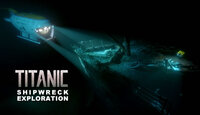
-
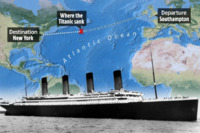
The Titanic was the name of the British luxury passenger liner that was traveling from Southhampton, England to New York City, NY when it sunk on April 14, 1912 in the middle of the Atlantic Ocean. This unfortunate tragedy has been an inspiration for authors, movie-makers, play-writers, and even billionaires and scholars who were left with much speculation about what happened and where the shipwrecks remain. The Titanic sunk in 1912, next The Titanic movie aired in 1997 (85 years after the tragedy), and now, 26 years later, billionaires attempted to reach the Titanic's shipwreck remains in 2023.
-
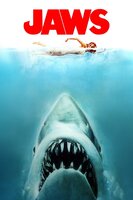
Jaws is an American "horror" film series that aired for the first movie in 1975 and has expanded to other 3 sequels, a theme park ride, and many more thanks to the entertainment industry.
The impact that this movie's release in 1975 had on society goes beyond the big screen and its revenue: the shark and ray population has seen an epic decrease of 71% with around 100 million sharks killed each year. The movie, although fictional, held the power to demonize sharks and also incite curiosity in marine biologists to research more about these misunderstood beings with the aim of preserving them.
Another perspective we must look at: "It’s a call to action for us to channel our love for thrilling tales into nurturing a deeper appreciation for the natural world." - Tanner Saul (2023)
-
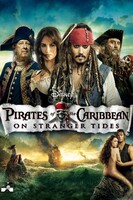
The Pirates of the Caribbean is a film series of American fantasy with the first movie airing in 2003. This movie was based on Walt Disney's theme park attraction and has served as a major contributor to the entertainment industry: not only as a blockbuster but for the Walt Disney world too.
The filming of these movies took place mostly in Queensland, Australia, taking over 7.4 hectares of natural habitat to occupy this land with the "pirate village" and other "greenscreen" sets, disturbing the ecosystem, not only the flora and fauna naturally but also by changing and manipulating in the locals' habitat.
-
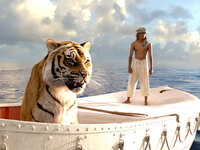
Life of Pi is an adventure/drama film that aired in 2012 and revolves around two survivors of a shipwreck and are left stranded in the Pacific Ocean for over 200 days. The survivors, however, are a boy and a Bengal tiger, thus making this movie that much more interesting. Production of this movie used a giant wave tank placed in an abandoned airport, it is known as the world's largest self-generating wave tank with a capacity of 1.7 million gallons of water.
-
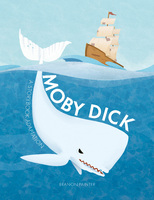
Moby Dick is a tale that everyone knows about. This novel was written by Herman Melville and published in 1851. Although not based on 100% real-life events, Melville adapted his life into this book: he was raised during the time of American dominance of the whaling industry in the mid 19th century. Using his own experience as a whaler as well as George Pollard's, the former captain of the whaler Essex, Melville wrote this American masterpiece which would later be adapted into hundreds of different movies, shows, comics, children's books, and even theatrical plays.
Environmentally speaking, Melville is able to depict whaling as brutal and destructive, he highlights the environmental toll that whaling takes on the oceans as well as other creatures by showcasing the interconnectedness of species to their natural habitat, oceans.
-

-

Sculpture created reflects animals in danger from the pollutants that it is made out of.
Artist: Washed Ashore Organization
-

NOAA Pacific Island Garbage Patch Map
-

This black and white photograph was taken by John Gutmann in 1939. It shows an exterior shot of soldiers, sailors, and civilians at a coast guard building located in San Francisco.
-
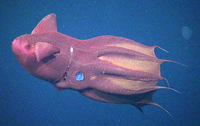
A red vampire squid photographed in the midnight zone
-
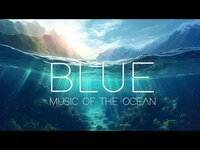
Music by Neil Myers, Matthew Rees, Lisa Van Hal, Markus Siegel, David Michael Tardy, and Kenny Mac. Artwork, animation, and playlist composition by Pandora Journey. These orchestral compositions are largely inspired by the movement, aquatic life, and ever-changing dynamics of the oceans.
-
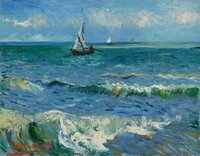
Artwork created by Vincent Van Gogh at the fishing village of Les Saintes-Maries-de-la-Mer, during a trip he took from Arles, France. The colors mimic those of the Mediterranean Sea. It is known that this painting was created at a viewpoint on a sandy beach in front of the ocean waves of Les-Saintes-de-la-Mer. In this painting, Van Gogh captures the essence and energy of the ocean. With his defined brushstrokes, a lively and dynamic atmosphere is created, closely reflecting the movement of the waves and the play of light on the water's surface. Van Gogh's use of a vibrant pallet of intense blues, cobalt, greens, yellows, and whites for the ocean and sky creates a sense of depth and character. His depiction of the water's movement through the interplay of light and color appears to closely mirror his fascination with the ocean and his desire to convey this emotional connection with viewers. By capturing the power and beauty of the sea, this painting invites viewers to experience the vastness and majesty of the ocean and to appreciate its significance in the natural world.
-
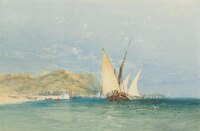
Artwork created by James Holland portraying the scene of sailboats docking at a coastline harbor. It depicts a bustling enviroment on the sea of relationships, businesses, negotiations, parties, gatherings and so much more. It shows the practical side of the ocean, its usefulness to our everyday life and demands an appreciation of its importance.
-
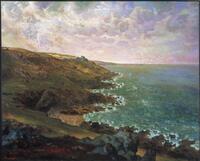
Artwork created by Phil Foster depicts the harsh beauty of the Normandy coastline. His work is meant to capture the everyday beauty that farmers and peasants worked alongside. During the period of the 1870s, the countryside served as a backdrop for peasants performing everyday tasks to survive. Foster saw the beauty in this everyday landscape and decided to capture its dangerous but beautiful essence. Les Falaises de Gréville also known as The Cliffs of Gréville highlights the imposing structure of the cliff, the wind-sculpted soil, rough seas, and heavy clouds. Symbolizing not only the beauty of things perceived as dangerous but also the beauty of everyday things. Foster, along with many other French farmers, looked out on this landscape every day. Instead of seeing it as the everyday view Foster found the beauty in a familiar sight. This painting evokes the message that anything, even familiar sights, can be beautiful and have secrets just waiting to be found.
-
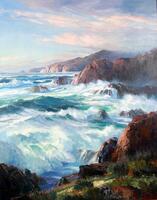
Artwork created by Bennett Bradbury envisions a coastal region with waves crashing up against rocky cliffs. Bradbury's work captures the beauty and power that the ocean possesses as the waves surge upwards as they meet the jagged coast. The vibrant turquoise and deep cobalt hues used contrasts against the white sea foam generated by the water's force. The salty ocean spray reaches beyond the waves as the droplets mist the rocks. The faint pink hint of a sunset graces the underside of the clouds that stretch across a blue sky. This painting evokes the strength of our natural world and the innate beauty which it possesses.
-
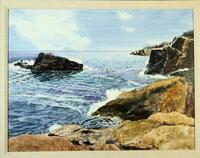
Artwork created by Phil Foster, an American artist portraying the vastness, depth, and beauty of the ocean. The Coast of Maine is known for its picturesque landscape and dangerous seas. Being very jagged with rocks sticking out into the ocean, Foster captures the essence of the coastline from its creation of wandering land masses colliding millions of years ago. Incorporating different hues of blue for the sea and sky and different yellows and browns for the rocks adds depth to the painting, capturing the feeling of being present at the coastline. Foster exemplifies the secluded natural location of the coastline, with no human civilization present. The Coast of Maine is a place away from everyday life. The rocks meet the sea which expands into the sky, symbolizing an escape through nature.
-
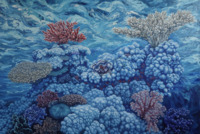
Artwork by Nikolina Kovalenko surrounding a philanthropy-driven exhibition benefitting the Coral Reef Alliance meant to portray the intricate nature of the ocean's once untouched coral reefs. The vibrant colors, textures, and depth evoke a sense of an idealized or dreamlike underwater environment. Through these techniques, Kovalenko draws inspiration from our once-untouched oceans to help push the need for the conservation of these unique structures home to thousands of aquatic organisms.
-
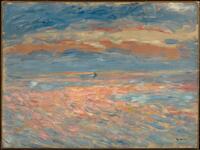
This piece by Pierre-Auguste Renoir from France creates an impression of the dramatic atmosphere created by ocean sunsets and the minuscule nature of human presence. Through his use of short, quick, loose brushstrokes and his intuitive use of color, Renoir captures the awe-inspiring view of a sunset by the beach. His painting conveys feelings of joy, leisure, and peace as one is transported to the oceanside, enjoying the fiery hues of the sun reflecting across the waves.
-
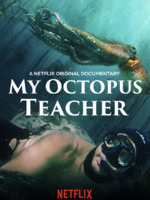
Directors James Reed and Pippa Ehrlich follow the life of Craig Foster who for years has been swimming every day in the ocean at the tip of Africa. On a random swim, Craig meets a female octopus who is remarkably curious. The film is months of footage of Craig visiting the octopus's den and tracking her movements, eventually gaining her trust. Craig and the octopus create an intimate relationship, never before seen between a human and a wild animal. The film represents an individual's connection to the ocean and how so unexpectedly one thing can change your life forever, even an octopus.
-
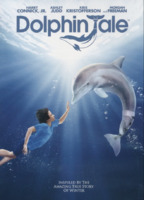
Director Charles Martin Smith creates this dramatic depiction based on the true story of Winter the Dolphin. This film follows the summer of a young boy named Sawyer who finds and untangles a hurt dolphin caught in a crab trap on the beach. Sawyer and Winter make a connection throughout the film, forming a personal relationship as doctors work to make Winter a prosthetic tail to be able to swim again. The film showcases how a lonely person can find hope again by connecting with the ocean and all of its properties like a dolphin.
-

This war poster by John Joseph Floherty portrays a woman in a blue coast guard uniform holding a pair of binoculars. She is positioned closer to the viewer, a green sailor silhouette positioned behind her. On the top the text says “Your Duty Ashore… His Afloat”, and on the bottom below the women it says “SPARS Apply Nearest Coast Guard Office”.
-
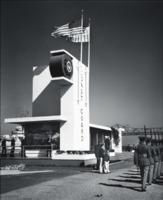
This black and white photograph was taken by John Gutmann in 1939. It shows an exterior shot of soldiers, sailors, and civilians at a coast guard building located in San Francisco.
-
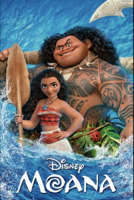
Directors Ron Clements and John Musker follow the life of Moana Waialiki, daughter of the chief on a dying island. A sea voyaging enthusiast, Moana takes the island's fate into her own hands and sets out on a journey to find the demigod Maui, who caused all the islands to start dying by stealing the heart of Te Fiti. There is an epic journey across the Pacific, having magical interactions with the ocean. This film is based on stories from Polynesian mythology and emphasizes the connection and life the oceans bring.
-
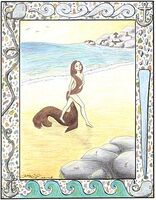
An illustration created Carolyn Emerick depicting a selkie in her human form along the shore of a beach. It shows the allure that selkies often have in Gaelic mythology when they aim to attract and lure men into dangerous situtations.
























